Posted by R. John Howe on 06-26-2007 03:37 PM:
Carpet Museum in Konya
Dear folks -
More impressive than its kilim museum is Konya's carpet museum. Again, Mehmet
Ucar took us to it.
Some of this material is very old. One piece is estimated to the 13th century
and a number of them are said to have been made in the 16th century.
It seems to me that some of this material is very strong and I'm puzzled why
some rug scholars have not taken it up for publication.
I took photos of about 50 pieces. Here are a first 10 images.
The first piece below is an unusual small, compartment design.
(Ed.: Since I posted it I have encountered a detail image of this piece in Iten-Maritz,
so some of this material has been published after all. There it is labeled "Seljuk
Konya, thirteenth century)
(Ed: Subsequent FLASH. This piece also appears in "Turkish Handwoven Carpets,
2" where it is decribed as residing at the Mevlana Museum in Konya. These analysts
have dropped the "Seljuk" indication from its description and estimate it to
have been woven in the 18th century.)

I think the piece below is one of those in this collection that impressed me
most.
(Ed: The piece below appears in "Turkish Handwoven Carpets, 2." It is said to
have been woven in Canakkale, in the 16th century.

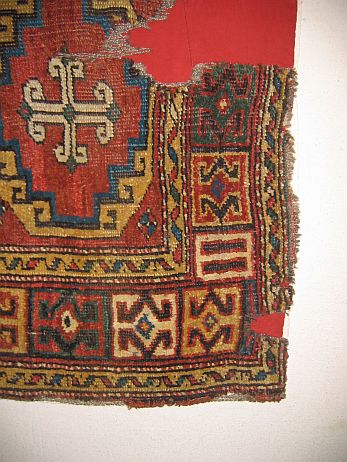

And a very similar but not quite identical closer image.




A very strong, suspicious yellow. But unless I am mistaken the gallery card
says 16th century.

A sedate, compartmented design below that cannot be shown full-length in this
relatively shallow room.

Unusual niche in the rug below.


As will become even more evident as we go along, some of these pieces are very
fragmentary indeed.
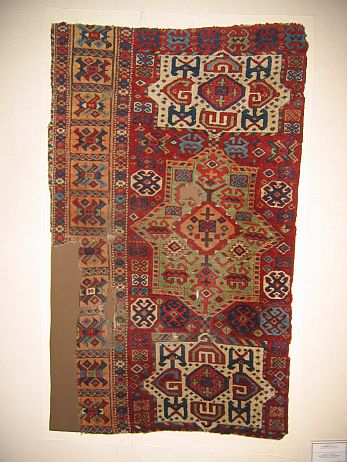
There may be some redundancy with images Pat Weiler has posted in his salon.
Pat was here before me. I've not tried to sort that out.
Regards,
R. John Howe
Posted by R. John Howe on 06-27-2007 06:04 AM:
Konya Carpet Museum, Second Set
Dear folks -
Here's a second set of images of rugs from the Konya carpet museum.

(Ed.: The piece below is included in "Turkish Handwoven Carpets, Volume 5" where
it is described as "Karadag, Konya, 18th century.)

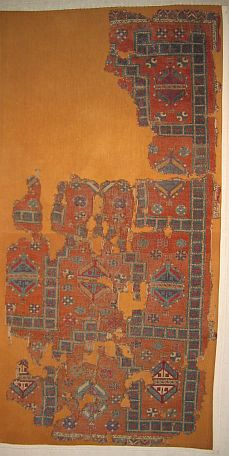
I didn't get the gallery label in my photo, but I think the rug below is one
of the older ones here.



The piece below is, of course, a fragment from a large medallion Ushak.

And this white ground piece, below, is a "bird" Ushak despite it being acknowledged
that the "bird-like" devices are not intended as birds.
(Ed: A much larger, better image of this piece appears in "Turkish Handwoven
Carpets, 4." It is estimated there to have been woven in Usak in the 15th century.
If anyone wants to see a better image of this piece, it is a rather familiar
type, signal and I'll scan it.)

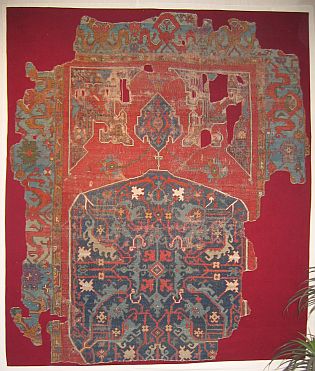
(Ed: The piece below appears in "Turkish Handwoven Carpets, 4." It is said to
have been woven in the 17th century in Konya.



I think the piece below is also one of the older ones in this collection.
(Ed: Iten-Maritz also shows a detail of this rug and seems to say that it is
15th century. He relates it to Turkish animal carpets of this same period (no
Turkish museum appears to have one of the latter). He calls attention to the
fact that a border is partly visible on the edges and that it is "consists of
resettes alternating with fabulous horned beasts.")
(Ed: This piece also appears in "Turkish Woven Carpets, 2," where it is also
estimated to have been woven in the 15th century in Konya.)


Maybe others will have things to say about some of these pieces.
Regards,
R. John Howe
Posted by Richard Larkin on 06-27-2007 08:07 AM:
Hi John,
Fantastic stuff. I've never seen the like of some of it.
__________________
Rich Larkin
Posted by Wendel Swan on 06-27-2007 08:12 AM:
Hi John,
While some of these images from the Konya Museum are of relatively well-known
types (yet still rare), two of them are design types that I cannot recall seeing
before. One is the sixth image in the first batch (with the yellow) and the
other is the third in the second batch (with the concentric block mihrabs).
The animal rug is fantastic.
This is exactly the kind of material that ought to be discussed on Turkotek.
Analogies from all these pieces can be made to much later work.
As to the rug with the strong yellow, I suspect that some dyes like the one
that created the yellow simply disappeared from use in Anatolia, Persia and
the Caucasus. Certainly Central Asian rugs have very strong yellows.
The 16th Century medallion rug in the Topkapi also had a very strong yellow
as well as other colors that made it almost look new.
Best,
Wendel
Posted by richard tomlinson on 06-27-2007 09:12 AM:
hi john
tremendous pieces !! i have to get to konya....
the piece that grabs me most is the last image - the bird/animal rug,,,,,,,,,,,,,WOW
........what's going on in the border??????
can you recall where it is said to be from?
thanks
richard tomlinson
Posted by Richard Larkin on 06-27-2007 09:37 AM:
Hi John,
I've got barbed wire wrapped around my leg to remind me not to reduce this to
a "Baluch" discussion, but since two stalwarts have already weighed in on the
repeating peacock (?) rug, I have to say that I would love to see an example
of the transitional bird between this one and the familiar device on Baluch
bags. Surely, they have to be related. Again, kudos on compiling these
pix.
__________________
Rich Larkin
Posted by Filiberto Boncompagni on 06-27-2007 09:51 AM:
Dear Richard(s)
Have a look at the recently quoted article Myth and Design by Tom Cole. Scroll at the bottom of the page.
Regards,
Filiberto
Posted by R. John Howe on 06-27-2007 10:37 AM:
Konya Carpet Museum, Third Set
Dear folks -
Here is the third set of images I have from the Konya carpet museum.
We may have seen an image of the piece below earlier but I included it here
to invite Wendel Swan to wax eloquently about the fact that there is an "open
top palmette" in its border. 
(Ed: A fragment very like the piece below appears in "Turkish Handwoven Carpets,
2." It is described as woven in Izmir in the 18th century and is said to be
in the TIEM collection in Istanbul.)

Some closer looks.







The gallery label on the piece below says that it's 18th century Konya.

A closer image shows how much light I'm losing at a distance.

There are some yastiks in this collection. The gallery label on one of them
(I can't tell which one of these images) said that it had been donated by Bethany
Mendenhall.
Many will know that Bethany and her husband Charles Lave usually manage the
dealers' fair at ACOR and at some ICOCs, as well. They travel to Turkey twice
a year. It's good to see that Bethany has made a concrete contribution to this
Konya collection.

The yastik below has a field design I have seen perhaps six or seven times over
the years. The field is filled entirely by a border pattern arranged in columns.

That's the end of the third set of Konya carpet museum images.
Regards,
R. John Howe
Posted by R. John Howe on 06-27-2007 11:37 AM:
Dear folks -
Here is the fourth set of images I took at the Konya carpet musuem.









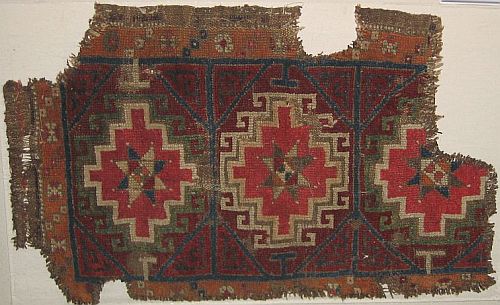
Regards,
R. John Howe
Posted by R. John Howe on 06-27-2007 12:38 PM:
Konya Carpet Museum, Fifth Set
Dear folks -
Here is the fifth and last set of images I took at the Konya carpet museum.
The piece below is a yastik.

There are also some fragments on the center posts in this museum near the yastiks.
Most of the pieces in the museum are on outside perimeter walls.


I liked this lattice design in the fragment below.
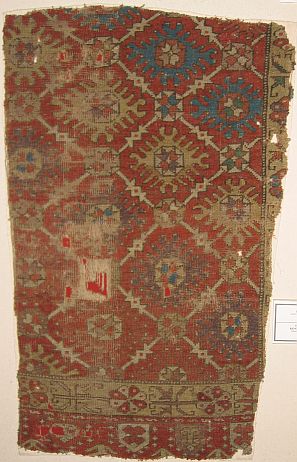

That is the end of the pieces I photographed at the Konya carpet museum.
Regards,
R. John Howe
Posted by Richard Larkin on 06-27-2007 12:51 PM:
Hi Filiberto,
Bravo for the great link, and thanks.
Hi John:
Bravo, bravo, bravo!!! This is just the best material. Almost all fragments,
too!!!
__________________
Rich Larkin
Posted by Richard Larkin on 06-27-2007 01:19 PM:
John, BTW, I notice you put that darkish Demirdji Kula in there. I think I
recall you once mentioning that type of rug wasn't quite your cup of tea. Right?
If so, I note there is a fairly well known version of that type of rug out there
that I consider, generally, to be a generation or so older than the one you
show (I may be off on that point). The one I refer to typically has lighter
coloring, featuring lighter reds, often in two close but distinct shades, and
a lot of mid blue and light yellow, and green. (Wefts are often yellow wool,
too.) The format tends to be about four feet by twelve feet or so. Decoration
is usually approximately four consecutive bilateral/directional medallion devices
with a lot of random (crazy?) filler surrounding them. Got the picture? Do you
know what I'm talking about? If I had the initiative of any number of Turkotekkers,
I'd find one and post it. Anyway, does your lack of enthusiasm for the type
extend to them?
__________________
Rich Larkin
Posted by James Blanchard on 06-27-2007 02:12 PM:
Bird migration...
Hi all,
I agree with Wendel and Rich. That "animal/bird" rug is fantastic, and I think
it deserves some discussion.
Maybe I can make a brief start, partly because I have been musing and reading
a bit about animal and bird figures in various types of weaving.
Filiberto has already cited Tom Cole's has recently published article about
this very type of Anatolian rug, and linked it to more recent Baluch weavings
and the birds that Baluch used in their weavings. Here are a couple of relevant
images of the Anatolian "birds".


Cole then illustrates a family of Anatolian "bird" models. 
As Cole mentions, the movement of different people groups in the last several
centuries make these design connections plausible, though it may be difficult
to sort out the direction of movement of design traditions.
Another suggestion with respect to "lineage" of these sorts of birds comes from
Opie, who suggests that ancient roundels with birds and other animals within.
An article by V.G. Moshkova, (reproduced by Tom Cole here ) illustrates some
similar bird forms.

Looking at these designs, it provides some food for thought, at least about
a couple of my rugs. First, here is a Baluch, most likely from NE Persia, with
a thin bird that looks very much like the Turkoman version illustrated in the
Moshkova article. This is a "thin" Baluch bird, not like the typical version
on "bird khorjins". Is this more Turkoman influence? Note the two diamonds on
the back, which I suppose might relate to the geometric figures on the Turkoman
piece illustrated above.

Another design figure that interests me is the widespread "curled leaf" border.
A number of authors have related this to ancient animal or bird forms. Figure
f. of the Cole diagrams seems to be a reasonable approximation to the "curled
leaf".
Perhaps others would be interested in exploring different bird motifs in rugs
and carpets in a separate thread, unless it has already been adequately covered
by Turkotek already.
James.
Posted by R. John Howe on 06-27-2007 04:11 PM:
Rich -
You wrote in part:
"...I notice you put that darkish Demirdji Kula in there..."
Me:
Well, there's a lot of evidence in our archives that I like a rather strange
variety of rugs and textiles, but I have occasionally confessed that I was not
enchanted with something.
Give me an image. Here's how.
Go to the image in question.
Put the cursor on it.
Left click.
Then right click and you will get a drop down menu.
Select "Properties" from that menu.
Highlight the line of code that appears and copy it.
Then go to a new post in this thread and copy the line of code into the body
of the message.
Put [img] in front of the line of code (no space) and [/img] behind it.
The image will appear in your post.
You can check it by going to the bottom of the screen in which you are writing
your post and clicking "Preview Reply." If it's not right, change it but if
it's OK go back down and click "Submit Reply."
I can respond better if I can identify precisely the piece you're asking about.
Thanks,
R. John Howe
Posted by R. John Howe on 06-27-2007 05:13 PM:
FYI
Dear folks -
My initial concern has been to get this material from the Konya carpet museum
"up," especially since it seems not to have been treated together in any publication
I have been able to find.
But now, as I go through the rather few volumes I have on Turkish pile weaving,
I am finding that some of these pieces have been published individually.
Since such individual publication often includes additional information, I have
begun to annotate my original posts with editorial notes. Such notes have this
format. (Ed.:....)
I have felt that it would be better to add such information near the original
images rather than to make new posts which would then need to be related to
distant images.
All this by way of saying that it may be worthwhile, occasionally, to start
again at the beginning of this thread and read through it, looking for such
editorial additions.
Regards,
R. John Howe
Posted by Wendel Swan on 06-27-2007 05:27 PM:
Hi John,
The last piece in the fourth set of images appears to be a yastik with Memling
guls in the field. Can you recall that its size was that of a yastik? And what
age was attributed to it?
A remarkably similar, but more intact, yastik was in the Private Yastiks Exhibition.
It was attributed to the 19th Century by its owner.
There are so many remarkable, beautiful objects in the Konya Carpet Museum but
there are a few that are less than stellar. The first piece in the fifth set
(a yastik) is really late and the ivory ground yastik has, as do many others
like it that I have seen, a running blue. There are different types of indigo
sulfonic and this may be one of the running varieties.
But I shouldn’t dwell on the lesser pieces when there are so many wonderful
ones to admire.
The rug with the geometric Cintamani field and the border that is either palmettes
or tulips in profile (I’m pondering that) presents some interesting questions.
Do you recall the age attributed to it?
Although the field is bolder, that rug reminds me of the style of the monumental
Seljuk carpet at the TIEM in that it has a very powerful border while the field
consists of relatively small, repeating designs. But I don’t think this rug
is Seljuk, however.
The variety of designs and patterns is amazing. I wish I had made it to Konya.
There is nothing like seeing these pieces “in the wool.”
Are you aware of a catalog for the museum?
Wendel
Posted by R. John Howe on 06-27-2007 07:11 PM:
Wendel -
I don't think there is an overall catalog. That's one reason I put all this
up quickly.
Yes, I agree the collection is uneven, but there are interesting and wonderful
things included.
I can't answer most of your questions for additional information. There were
gallery labels, but I couldn't take the information in the time we had. And
they usually give only attribution and estimated age.
I'm going through the books I have that treat Turkish pile carpets, looking
to see if any of the Konya carpet museum rugs have been treated individually.
As I've indicated in my immediately preceding post, I'm annotating my original
images with information I find. It will be marked (Ed....) If I find answers
to some of your questions I will post it there in that format.
Most museums can only put out a part of their holdings, often a small part.
I've found what I think are some Konya carpet museum pieces that have been published,
but which were not on display when we visited. I may scan them for interest.
Regards,
R. John Howe
Posted by R. John Howe on 06-27-2007 09:28 PM:
Dear folks -
I've been through my rather limited Turkish pile rugs volumes, but have found
some additional information and have made annotations to some of the pieces
above.
I think I have provided what I can for the moment.
I would be grateful for indications and elaborations that others might offer.
Rich Larkin -
I hope you were not put off by my responding by giving you directions for providing
an image. It's hard to respond if the reference is not clear. Wendel did it
too. Ask about a certain number rug in a particular series. In a situation like
this it's best simply to insert the piece of interest into your post so as to
make the reference clear to everyone. And I think it's relatively easy to do
(of course, I say that from a position of having learned to do it some time
back; I could well under-estimate its difficulty if I were learning it now from
scratch). Anyway, hope I didn't offend.
Regards,
R. John Howe
Posted by Richard Larkin on 06-27-2007 09:51 PM:
John:
You couldn't offend. I haven't put in the image because I haven't had time,
but I will and I appreciate the guidance on tools and techniques. (I've also
run Filiberto through the traces, and no doubt Steve now and then as well.)
In the meantime, I didn't intend to burden you with a wild goose chase either.
As evident to all, you have enough to do. I know you are an afficionado of Anatolian,
and I was just interested in your view of the particular type. (I have a faded
glorious example in the master bedroom closet, which, when it is Martha designing
the closet, resembles an airplane hangar, so the rug fits fine.)
__________________
Rich Larkin
Posted by R. John Howe on 06-28-2007 07:28 AM:
Rich -
I LIKE some Turkish rugs a great deal. I like lots of yastiks, but am especially
attracted to what we call "Turkish village rugs." That said, I actually know
rather little about Turkish rugs and flatweaves in general. I don't for example
own the Bruggeman (sp?) and Bohmer classic on Turkish tribal rugs because it's
$600 now.
Now about Kulas. I fear I am not very fluent concerning the various types and
the adjective you used to narrow the field did not conjure an image for me.
I think the only time I might have said something generally adverse about Kulas
is when I reviewed a book I had bought that was written in 1900 which claimed
that only 15th, 16th and 17th century rugs were (then) worthy of collection.
That writer aimed at 19th century Kulas and Ghiordes rugs as particular examples
the comparative merits of which he could not see.
But I'm not actually knowledgeable enough about Kulas to say much about them
on the basis of a verbal trigger.
Now if you give me an image I'll tell you what I "like." 
By the way, my call for an image may be an instance of "different strokes."
Wendel has said to me on the side that he is put off by repetitive images. So
there may be no generally satisfying practice.
Regards,
R. John Howe
Posted by Richard Larkin on 06-28-2007 08:51 AM:
Hi John,
It may be a day or two before I can zero in on your image instructions. In the
meantime, the Kula I was referring to (the ilk of which I thought I recalled
you disapproving) is the third rug following the "bird rug" in this post. It
immediately follows one you mentioned as having appeared in "Turkish Handwoven
Carpets 4," 17th century Konya. The one I'm pointing out is what I would expect
to be assigned to the 19th century, not too early therein.
Don't bother trying to connect it with my drawn out description of a cousin
rug.
__________________
Rich Larkin
Posted by R. John Howe on 06-28-2007 09:59 AM:
Rich -
Is it this one?:

This seems to have the labeling you quote in the text.
I got confused by the "bird" reference, since there are two pieces that could
be said to have "birds" in them. But I'm suspecting that you referenced the
"bird" Ushak in your question.
To respond, this Kula piece does not excite me particularly. If I was to pick
one with a similar darkish palette (this latter piece may be a yastik) I think
I prefer this one:

I think the drawing and the use of associated colors is better in this second
piece. And, of course, it has something that is close to "compartments." 
Hope that helps.
Now, if you have/find a "Demirdji Kula" with a somewhat lighter palette, it
might well be one that lots of us would like. I do have to admit that a 4 foot
by 12 foot size would be disqualifying in a one-bedroom condo, but that latter
is "interior decorating" not the evaluation of a rug's aesthetics.
Regards,
R. John Howe
Posted by Richard Larkin on 06-28-2007 10:46 AM:
Hi John,
Thanks for the comment. That is the one. It is a size, design and color scheme
that I have seen before, and I recall you having commented unfavorably on one
some time ago on these lines. The "other" one I refer to is also familiar in
color, design and format (although different than the [later?] one you've illustrated).
The familiar older type of Demirdji is illusttrated here and there in some of
the older books, but I don't recall just now which ones.
If I can get a photo of mine and avoid annoying my friend, the long suffering
Filiberto (by having my image file too big), I'll post it in order to complete
this anti-climax.
__________________
Rich Larkin
Posted by R. John Howe on 06-28-2007 03:49 PM:
"Block Mirhab" Design
Dear folks -
One of the designs here that Wendel indicated is new to him, is that of the
fragment below.

The feature that seems to have attracted Wendel's attention is the central column
of "block mirhabs" in compartments.
I'm just making it clear here which rug he was citing.
Regards,
R. John Howe
Posted by Richard Larkin on 06-28-2007 05:17 PM:
Hi John,
It looks like a child laid it out on the floor with his set of blocks. It's
interesting, albeit not the most graceful of carpet designs.
__________________
Rich Larkin
Posted by Wendel Swan on 06-28-2007 06:09 PM:
Hi John and all,
Yes, that is the rug I had in mind. Of these two, it is now on the right:


The concept of stacked mihrabs is the same as in the rug on the left (a type
quite commonly seen), but I can’t recall seeing any Anatolian rug where a design
is created with just squares. So many of the rugs seen in the TIEM and the Konya
Museum are rare. We almost needn’t point that out. But the rug to the right
is, as are others, what the English refer to as a one-off.
This rug is certainly interesting and probably quite old. I don’t know if I’d
consider it beautiful, but I think I’d enjoy seeing in person what’s left of
it.
Wendel
Posted by Patrick Weiler on 06-28-2007 07:52 PM:
More Konya pix
John,
Here are a few photos I took in the Konya museum.
The rugs were in a large downstairs room. Some were unremarkable, but many were
quite striking.
We visited a few rug stores in Konya, but there was only one with more than
a few older rugs. The owner said there used to be several more, but the dealers
either left the business or gravitated to Istanbul. When there were more old
rug stores, many more buyers went to Konya, but it is not the mecca it once
was.




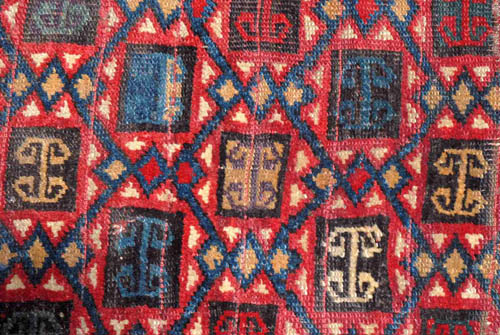
I should have hired a secretary to follow me around taking notes on each rug,
but the pictures will have to do!
Patrick Weiler
Posted by R. John Howe on 06-29-2007 06:53 AM:
Pieces "Not Out in May" at the Konya Carpet Museum
Dear folks -
I mentioned that as I looked through the "Turkish Handwoven Carpets" series,
I saw some pieces said to be in the Konya carpet museum collection but which
were not "out" when we visited that museum in May.
Mostly, they are not extrodinary pieces, but in the interest of having all of
the images from this museum together, I scanned them and have listed them below
with the attribution and estimated date provided.
Here they are:
The piece below is said to be 19th century and woven in Ezine, Canakkale.

The rug below is also identified as from Canakkale. Estimated as 19th century.

The severely damaged piece below is described as 18th century Konya.

The carpet below is said to have been made in Sivas in the 19th century. There
are field devices that edge on to the curvilinear.

The rug below is described as woven in Elmah, Kirsehir. 19th century. It has
unsually wide borders. Graphically, too complex. Too much going on everywhere.
The borders, which are attractive, overwhelm the field. Colors are good.
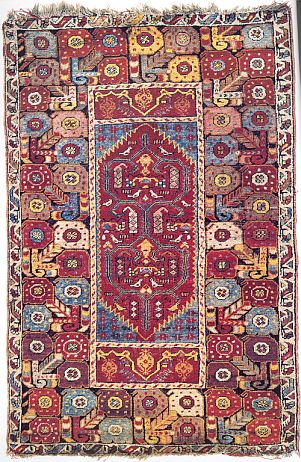
The piece below is also described as from Kirsehir, but is estimated as 18th
century. It has some interesting features. First, there is a surprising curvilinear
device in the center of the field.

A close-up of the border shows another feature I can't recall encountering before.
The tops of the "tree-like" or "boteh-like" dark blue forms intrude with their
tips into the ajoining minor border. I notice that this usage has been corrected
in the cartoon based on this rug.

The carpet below is also from Kirsehir in the 19th century.

The drawing has a rather modern feel to me. Field devices seem to exhibit conventionalization.
There is a nice blue, and a strong yellow contributes to a pleasant coloration.
The piece below is describe as from Mucur, Kesehir in the 18th century.
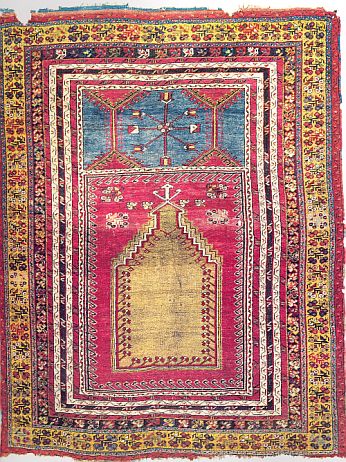
Cross panels are fairly rare in most rug varieties, other than the Turkmen engsi,
but they are fairly frequent in Turkish rugs. I think this particular cross
panel is interesting.
That, I think, is the end of what I can show you of pieces at the Konya carpet
museum.
Regards,
R. John Howe
Posted by R. John Howe on 06-29-2007 07:22 AM:
Dear folks -
Wendel Swan has called attention to a couple of Konya carpet museum rugs.
Addititional information about one of them is provided by the "Turkish Handwoven
Carpets, 2" volume. Here is the overall image from this volume.

Perhaps the most important indication made here is that that this piece is estimated
to have been woven in Konya in the 13th century. It is labeled "Selcuk."
But as you can also see, the image above, which has been reduced to fit the
screen, is not really an improvement on the taken images we already have. There
is, though, a detail from a cartoon made based on this rug.

This cartoon detail reveals that the "blocks" have a definite internal instrumentation.
It also draws attention to how dramatic the multi-color, chevron border of this
piece is.
The text, which seems not to be trustworthy in some areas, may make a sound
observation when it indicates that such rugs usually exhibit seven niched levels
(the analogous piece Wendel provides comparatively above does). This suggests,
they say, (since only three levels are visible in this fragment) that this rug
was actually much longer.
Regards,
R. John Howe
Posted by Wendel Swan on 06-29-2007 07:40 AM:
Hi John,
You yourself have observed that in this series of books the text "seems not
to be trustworthy in some areas..." and "This suggests, they say, (since only
three levels are visible in this fragment) that this rug was actually much longer."
The end borders are both clearly visible. Once again the unreliablility of the
text in this series is demonstrated. A great deal of it would be laughable if
it weren't for the fact that these books came from the home country of the production
of these great rugs and might be considered by others as trustworthy because
of that.
There is a somewhat analgous rug in the TIEM with four rows of mihrabs.
Wendel
Posted by Richard Larkin on 06-29-2007 07:42 AM:
Hi John,
Even though some of these pieces aren't masterpieces, I find the surprising
variety hugely interesting. Again, thanks so much for all your efforts in bringing
them to us. Also, I think some of the pieces might grow on one after acquaintance.
(I sort of like the one you find too complex.)
__________________
Rich Larkin
Posted by R. John Howe on 06-29-2007 08:09 AM:
Wendel -
We talked on Turkotek once before about the "Turkish Handwoven Carpets" series.
It exhibits the hallmarks of a government-run project with multiple objectives.
It seems that the authors wanted to:
Document the traditional variety of Turkish pile carpets.
Provide some modest information about them such as where they were woven and
an estimated date. They also usually provide provenance, size and a vertical-horizontal
knot count.
They have included details of a cartoon that has been made based on each piece
(this latter suggest that this is effort is, in part, one intended to support
rug producers who might want to make such traditional designs).
I am not sure why they decided to devote most of the sparse text to design interpretation.
Maybe, since everyone loves to speculate about rug designs, they thought that
that would help sell the volumes. Anyway, there is a design intepretation section
and it is often laughable.
The color is not particularly good, but the large scale of the pages provides
the space for larger images and sometimes, even with problematic colors, they
give another perspective on what the pieces look like.
So I share with you some scorn for aspects of this effort, but until we have
a competent, comprehensive book on Turkish pile weaving, this series has its
modest uses.
Rich -
I confess to liking, a little, too, the piece with the over-size borders. We
are allowed to like a piece in spite of its faults, as long as we do not do
so because of them. 
Regards,
R. John Howe
Posted by Marty Grove on 06-29-2007 01:58 PM:
Pieces from 'Not out in May'
G'day John and all,
There have been so many fantastic rugs you have shown us, that it is difficult
to pick the best from many, and its always interesting to look at such a plethora
of them.
In the '...May' selection, the very first orange and blue one from Ezine in
Canakkale really grabbed me like a crab - so expressive is the idea of the field
I could almost literally feel its clutches ... seriously
No 6 from Kirsehir also took my eye for the floral arrangement in the field
and the bright saturated dyes - it makes a dramaticly colourful picture. I'd
have it.
Thanks for showing them all to us, John, and also to your fellow contributors.
Regards,
Marty.











































































